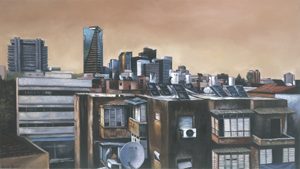The series of paintings “Untitled” (2008) features the buildings on the street painted from a high vantage point, a perspective based on spatial control, overlooking the city all the way to the horizon. People are nowhere to be seen in these works. The residents of the city’s southern regions are absent. As an inhabitant of the neighborhood, Bacri witnesses a constant change of tenants, a neighborhood where people come and go-new immigrants, foreign workers who are being expelled, refugee labor immigrants, day laborers who stay in it for limited periods. Bacri freezes an imaginary tranquility of an urban space on the verge of being violated. The entry of a human element into the painterly frame holds the potential of threat and destruction. Its absence charges the space with a sense of danger and emergency, further reinforced by the apocalyptic pink-orange twilight sky in many of the paintings. For one apocalyptic moment, the neighborhood in Tel Aviv’s south, on Jaffa’s pre-1948 border, appears in Bacri’s paintings as a ghost town, implicitly alluding to the Palestinian villages which existed there before the Nakba: Sheikh Munes, Samui’l, al Manshiyyah, Salame, Abu Kabeer, Irsheid, etc., places of settlement which were located in what later came under the jurisdiction of the city of Tel Aviv-Jaffa, were emptied of their inhabitants and kept unpopulated.
In the history of Western photography, erasure of the human element in architectural photographs of the modern era is common. In this tradition the buildings and the city emerge as objects of modernity and progress, whereas people, with their class and ethnic specificity, might interfere with the timeless pretension of the new city. Bacri’s realistic meticulousness is influenced by this tradition, but the visual information conveyed by the paintings undermines the timelessness of the new city by exposing timeworn electric lines, rusty sewer pipes and water boilers, old buildings and cracked balconies and walls.
The imprints of the time that has passed are discernible in the unusual painting Timeworn Fishing Boat in Jaffa Port (2008) where Bacri depicts wreckage of a fishing boat on the Jaffa beach, with its decaying wood and broken beams. Bacri, however, portrays the boat from within, from a unique perspective that generates a structure, a construction, of the wooden beams, which also serves as a shelter. The sense of shelter offered here alludes to the memory of the human experience of the Palestinian fishing boat, and its function in the daily life of the fishermen in the port. Bacri created several paintings of these boats, tipped on their side, half-buried in the sand, which serve as memorials for a history now gone, removed from the beach by the city’s bulldozers.
Born in Acre, 1982. Lives and works in Tel Aviv-Jaffa.
Less Reading...
